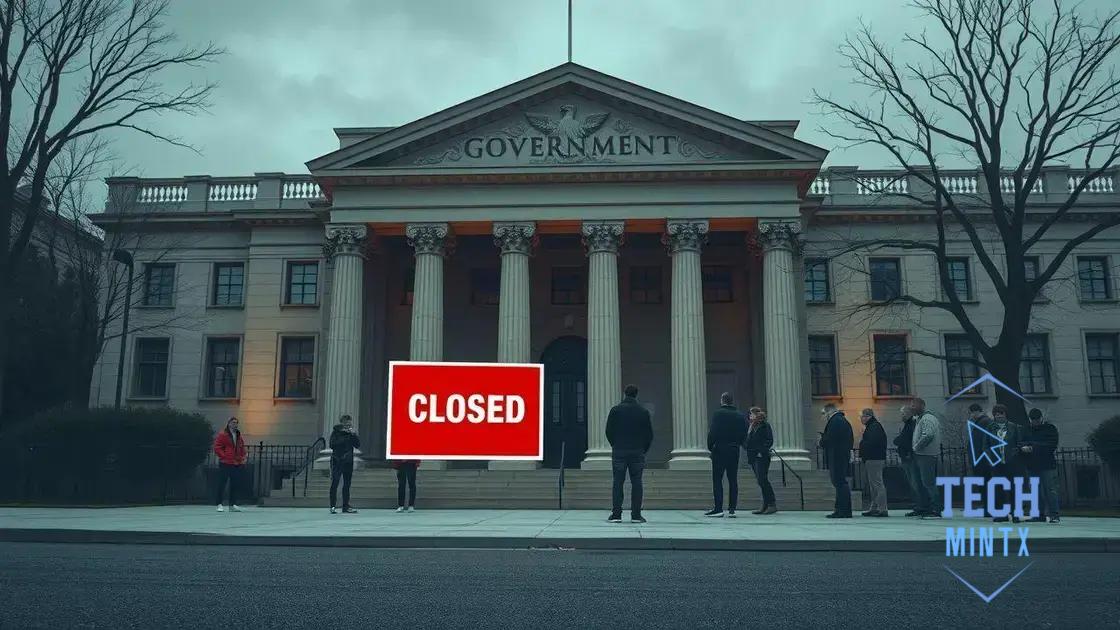Federal shutdown risks delay benefits delivery for many

Federal shutdowns risk delays in benefits delivery, potentially affecting crucial programs like Social Security and food assistance, which can create significant disruptions for individuals and families relying on these services.
Federal shutdown risks delay benefits delivery for countless families across the nation. This situation raises serious concerns about access to essential services. Curious about how this might affect you? Let’s explore the implications together.
Impact of federal shutdowns on citizens
Federal shutdowns can have a profound impact on citizens, especially those who rely on government services and benefits. These closures lead to delays that can disrupt daily life, creating uncertainty and anxiety for many.
Economic Consequences
During a federal shutdown, the economy often takes a hit. Workers in federal jobs may face furloughs, leading to reduced income. This situation can affect local businesses that rely on federal employees for sales and services.
Disruptions in Services
Shutdowns lead to significant disruptions in essential services. The following services may be affected:
- Social Security: Payments may be delayed, creating financial stress for those who depend on them.
- Food Assistance Programs: Programs like SNAP could face interruptions, leaving families in need without support.
- Veterans Benefits: Timely access to benefits can be jeopardized.
- Public Safety: Agencies like the FBI and Coast Guard may operate with limited staff, affecting public safety.
Additionally, health services like the CDC might delay programs that are vital in emergencies, such as disease outbreaks. Citizens relying on these services must brace for delays and uncertainty.
Impact on Families
The emotional toll of a federal shutdown cannot be overlooked. Families may experience anxiety over job security and timely benefits. It’s crucial to understand that while some programs may continue to function, their efficiency and effectiveness can be considerably hampered.
Moreover, the uncertainty surrounding shutdowns can cause strain in relationships. Families may find it challenging to make long-term plans, contributing to a sense of instability. This prolonged uncertainty affects mental well-being and the overall quality of life.
How benefits are affected during shutdown

During a federal shutdown, many benefits that individuals and families rely on can face significant delays. This situation can create a lot of uncertainty and anxiety for those affected, as they may not know when they will receive essential support.
Types of Benefits Affected
Various programs face interruptions during a shutdown, impacting numerous citizens. Some of the key benefits affected include:
- Unemployment Benefits: Applications may be delayed, leading to financial strain for job seekers.
- Food Assistance: Programs like SNAP may halt new applications or reviews, making it hard for families to access food resources.
- Social Security Payments: Beneficiaries could experience delays in their payments, which are vital for their daily living expenses.
- Veterans Benefits: Services that veterans depend on for healthcare and support might be delayed.
These delays can cause ripple effects in households, where budgeting becomes a challenge. Individuals relying on fixed income from benefits like Social Security may find it particularly difficult to manage without timely payments.
Long-Term Consequences
Beyond immediate delays, the impact can extend into the long term. For instance, families may find themselves in debt due to reliance on credit during these times. They might have to pay higher interest on loans or credit cards just to meet basic needs.
Furthermore, the anxiety and stress associated with these delays can lead to mental health challenges, affecting overall well-being. It’s important for citizens to stay informed about their benefits and plan accordingly during such uncertain times.
Historical examples of shutdown impacts
Understanding past federal shutdowns can help illustrate the potential impacts on citizens and government services. Historical examples provide insight into the effects these events have on the economy and daily life.
1995-1996 Shutdown
One of the most notable shutdowns occurred in 1995 and lasted for 21 days. This shutdown resulted from a budget dispute between Congress and President Clinton. Essential government services were disrupted, including national parks and the issuance of certain federal permits. As a result, many federal employees were furloughed, impacting their income and spending power.
2013 Shutdown
Another significant shutdown took place in October 2013 and lasted for 16 days. This event stemmed from a disagreement over the Affordable Care Act. During this period, approximately 800,000 federal workers were sent home without pay, and numerous services were halted. Public health initiatives were particularly affected, including the CDC, which saw delays in critical public health work.
Economic Repercussions
Federal shutdowns can have long-lasting effects on the economy. For example, the 2013 shutdown reportedly cost the U.S. economy about $24 billion. Small businesses that rely on federal employees for their income faced significant challenges. As federal workers cut back on spending, local economies also suffered, creating a ripple effect that extended beyond the immediate impacts.
Moreover, the uncertainty surrounding these shutdowns can lead to decreased consumer confidence. Individuals may hesitate to make larger purchases, further slowing economic growth. These examples illustrate how historical federal shutdowns serve as cautionary tales about the impacts on families and communities across the nation.
Ways to prepare for potential delays

Preparing for potential delays during a federal shutdown can help individuals and families manage the uncertainty that comes with it. Proactive steps can make a significant difference in how smoothly people navigate these challenging times.
Build an Emergency Fund
One of the best ways to prepare is to create or boost an emergency savings fund. This fund should cover essential expenses for at least three to six months. Having this cushion can provide peace of mind during a shutdown.
Stay Informed
Another key to preparation is staying updated on government news. Knowledge about ongoing discussions and potential shutdowns can help families make informed choices. Following reliable news sources and government updates can provide timely information.
- Check government websites: Follow official social media accounts and websites for announcements.
- Join local community groups: Networking with others can give immediate insights into local impacts of a shutdown.
- Talk to your employer: Understanding how your employer plans for potential shutdowns can help with your personal planning.
In addition to these steps, it’s important to assess personal finances. Making a budget that prioritizes essential expenses can help maintain financial stability. This way, families can identify areas where they might cut back if needed.
Plan for Food and Supplies
Stocking up on essentials can also ease anxiety about potential interruptions. Keeping a few extra non-perishable food items and household supplies on hand can make challenging times more manageable. Planning meals around pantry staples ensures that families continue to have nutritious meals during a shutdown.
Taking these proactive measures can greatly assist families and individuals in navigating the challenges of a federal shutdown, reducing the stress that comes with uncertainty. By planning ahead and being informed, individuals can sleep a little easier during these turbulent periods.
What to expect during future government closures
Knowing what to expect during future government closures can help citizens stay prepared and reduce anxiety. Federal shutdowns have become more common, and understanding their potential impacts is crucial for everyone.
Delayed Services
During a government closure, many services you rely on may experience delays. Essential programs such as Social Security and food assistance might see interruptions. It’s critical to plan for these possible delays, especially if you depend on these services for your daily needs.
Furloughs and Economic Impact
Federal employees often face furloughs during shutdowns, meaning they are temporarily out of work without pay. This can lead to financial difficulties for many families, as their income is significantly reduced. The economic effects can ripple through local communities, affecting businesses that rely on spending from federal employees.
- Reduced consumer spending: With fewer resources, families may cut back on spending, affecting local stores and services.
- Increased stress: Financial instability can lead to stress and uncertainty among families trying to cope.
- Market reactions: Investors often respond to the uncertainty of government closures, which can impact stock market performance.
Each shutdown differs in its duration and effects, but communities often feel the impact in similar ways. Being aware of these potential outcomes can lead to better preparation.
Continued Uncertainty
Another expectation is a wave of uncertainty. Citizens might wonder whether future closures are likely and how long they might last. Keeping informed through official government communications can provide clarity on ongoing discussions in Congress. Many individuals may feel anxious as deadlines approach, fearing the possibility of another shutdown.
By being prepared and informed, individuals and families can navigate the challenges that come with potential government closures, making necessary arrangements to support themselves during these uncertain times.
FAQ – Frequently Asked Questions about Federal Shutdowns
What is a federal shutdown?
A federal shutdown occurs when Congress fails to pass sufficient funding for government operations, causing non-essential services to close temporarily.
How do federal shutdowns affect benefits?
Federal shutdowns can delay benefits such as Social Security and food assistance, leading to disruptions for those reliant on these services.
What should I do to prepare for a potential shutdown?
It’s wise to build an emergency fund, stock up on essentials like food, and stay informed about government news to reduce uncertainty.
How long do federal shutdowns typically last?
The duration of federal shutdowns varies but can last anywhere from a few days to several weeks, depending on negotiations in Congress.





